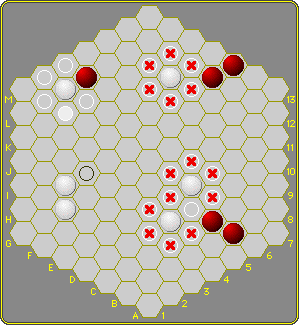HexOust cannot end in a draw.
 | The diagram shows a base-7 board. There are two players, Black and White. Both have a sufficient number of stones in their color. At the start of the game the board is empty. Black moves first. Rules Definition: a group consists of one stone or two or more like colored connected stones. Note that in these rules, reference to a 'group' will include a single stone. Object The object of Oust is to capture all opponent's stones on the board. |
Play
There are two kinds of legal moves a player can make:
- Non-capturing move
A player may put his stone on any empty cell if that stone does not enlarge one of his own groups. - Capturing move
A player may put his stone on an empty cell if that stone does enlarge one or more of his own groups, if and only if by doing so the player creates a group (implicitly including the placed stone) that meets the following conditions:
- The player's new group of stones touches at least one opponent's stone.
- All opponent's groups touching the moving player's group must be smaller than that group.
 | Examples The marked point J10 shows a capturing move. By placing there Black creates a group of three black stones that touches one white group containing two stones and another white group containing a single stone. Both white groups are smaller than the formed black group so this is a legal capturing move. Six cells down the result is depicted: Black has a group of 3 and the three capured white stones have been removed. |
 | If stones of different color are adjacent to begin with, the capturing stone does not have to be the 'contacting' stone: top-left white moves J7 (the four open white markers show alternatives for capturing). By placing here, White creates a group of two white stones that touches one black group containing a single stone. This black group is smaller than the formed white group so this is a legal capture. Four cells down the result is depicted: White has a group of 2 and the capured black stone has been removed. Top-right four moves are illegal for white because they would enlarge a white group, while H11 and I12 are illegal because the resulting white group of 2 is not be bigger than the black group. The bottom-right situation shows nine illegal extensions for white, and one legal move to capture the black group. |
 | Since every capture results in the moving player having to make another move in the same turn, sequential captures are possible. With (1) black captures the group of one, after which (2) captures the group of two and (3) the group of three. The result is depicted five cells down. External links HexOust © Mark Steere |
